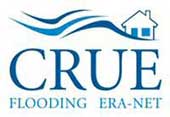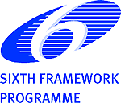The European Project CRUE ERA-Net
ERA NET CRUE
 |
 > > |
Since November 2004, APAT, now ISPRA, has participated, as the only Italian Institution, through the Department for the Protection of Inland and Marine Waters, to the project CRUE ERA-Net, a European coordination action on researches dedicated to the flood risk management. The project, funded through the Sixth Framework Programme for Research and Technological Innovation (FP6) on the priority “Global Change and Ecosystems” thematic area “Sustainable Development”, with a total budget of € 3 million, is part of the ERA-Net scheme, which is aimed at integrating and strengthening the European research area. The projects of the ERA-Net programme are indeed aimed at improving cooperation and coordination of research activities conducted at national and European level, putting them in a kind of Community-level network shared and open to all the possible contributions of experience and development coming from national public bodies of the Member States that finance and manage research and technological innovation programmes.
In the framework of FP6, the CRUE consortium, consisting of 16 partners from 12 European countries or regions, has been coordinated by DEFRA, the Department for Environment, Food and Rural Affair (UK), and has developed strong synergies with other projects of FP6, such as FLOODsite, and of the ERA-Net scheme, in particular on water-related issue, such as CIRCLE, IWRM-Net, SKEP SNOWMAN and SPLASH, also in anticipation of future integrations, and with the Working Group F on Floods of the EC Common Implementation Strategy for the Water Framework Directive 2000/60/EC.
After the end of the European Commission funding under the FP6 umbrella (October 2009), the ERA-Net CRUE consortium has decided to continue the co-operation on joint research initiatives (see the 2nd CRUE ERA-Net Funding Initiative on the CRUE website) and to explore opportunities for maintaining and extending collaboration in the future. In such new co-operation framework, the chair of the Steering Committee is rotated each year. From November 2009 to October 2010, the Austrian partner, namely the Federal Ministry of Agriculture, Forestry, Environment and Water Management (BMLFUW), took over the chairship. Since November 2010 and until October 2011 the Steering Committee is chaired by ISPRA. Later on, the chairship will be taken over by the Environment Agency (EA) of England and Wales.
What is the context in which the CRUE project is located?
- In the EU Member States, the flood risk management (and related research) is the responsibility of central government and, in some cases, of the local government
- Factors that influence the research policy on flood risk management differ from country to country
- Most of the river basins in Europe are shared between several Member States (about 80%)
- Current research programmes at all levels are structured differently in the common European space.
- In Europe, there is no consultation and no coordination on the planning of research on the topic of flooding, with duplication of effort and lost opportunities
- No common integrated and systematised information system.
Main activities of the CRUE ERA-Net project
In order to enable a common European space in the dissemination of information on national programmes on flood risk management, an information system, called CRUISE - CRUe Information System Europe, has been prepared, which lists about thirty national research programmes and it has been expanded with a number of national research projects, including those related to the implementation of the surveyed programmes, and with Community projects. This continuous survey about the programmes and research projects financed by the European Commission – and above all – by all Member States participating in the CRUE consortium allowed conducting a thorough analysis on the issues addressed by each programme, the management of the programmes and the different types and sources of funding. The results of the analysis, reported in a publication entitled “National Research Programmes on Flood Risk Management across Europe” which is available on the project website, showed a predominance of programmes focusing on natural and technical sciences rather than on socio-economic sciences. In other words, the study of natural processes – meteorology, hydrology, hydraulics, etc. – provides the necessary basis for risk assessment approaches and the evaluation of potential impacts of flood events, but also for protection measures and response strategies against floods.
The vision for the CRUE ERA-Net is to facilitate the strategic integration of research at the national funding and policy development levels within Europe, and to promote the sustainable flood risk management. For this reason, great relevance has been also given in developing common goals and principles in funding of flood-risk related research across Europe. Through the organization of ad hoc workshops, attended by policy-makers, practitioners, stakeholders and researchers from Europe and USA (namely the US Army Corps of Engineers), and the active involvement of national experts into the project activities, the needs, gaps and aspirations of both policy and practice on flood risk management in order to face the challenge of flooding in Europe have been identified. This results in the realization of the CRUE’s Research Agenda, which was approved by the CRUE Steering Committee on the 20th April 2009, during the 9th Management Committee Meeting organized by ISPRA in Rome. The purpose of the CRUE’s Research Agenda is to guide all those who are collaborating on a shared research initiative, whether from a governmental, policy, funding, science or practice perspective; to provide a clear set of research priorities at European or national level; and to support EU Member States in the implementation of the EU Floods Directive 2007/60/CE by providing scientific evidence and approved tools in the area of risk assessment, mapping, and visualisation.
A valuable way of delivering targeted research and development responses to such commonly agreed challenges is given by the two Research Funding Initiatives launched by the CRUE consortium in 2005 and 2008, respectively. Seven trans-national research projects designed to evaluate the effectiveness and efficiency of non-structural measures in flood risk management have been funded by 6 partners of the CRUE consortium under the 1st Funding Initiative, with a total budget of about € 1.6 million. The final reports of these projects, which concluded their activities at the end of 2008, are available on the CRUE website.
In June 2008, twelve of the CRUE partner countries decided to launch a further call to explore how best to improve flood risk awareness, public participation and incident response, as clearly requested by the Floods Directive. Having at disposal a total budget of about € 2.6 million, seven trans-national collaborative research projects, with test sites all over Europe, plus one scientific coordination project, have been funded by such second common call. The Kick-off Meeting for the 2nd Funding Initiative was hosted by ISPRA in Rome on 19-21 October 2009, whereas the Mid-term Seminar was hosted by the Spanish partner, the Ministry of Science and Innovation, in Madrid on 19-20 October 2010. An Interim Report collecting mid-term results was presented during the Madrid Seminar. The Final Symposium for the presentation of the project results, hosted by the Austrian partner BMLFUW, was held in Graz on 19-20 September 2011, in connection with the International Symposium “Urban Flood Risk Management – Approaches to enhance resilience of communities” (21-23 Sept.), where a Special Plenary Lectures on CRUE was held on the first day.
For each of the seven trans-national research projects, an overview on activities and results is available as Final Report on the CRUE ERA-Net website — under the “Calls for Research” section / “Project List” sub-section of the 2nd common call. Synthetic factsheets on case studies and methodologies developed and implement during the two-year research period will be soon available on the above-mentioned section. The scientific coordination project, in collaboration with the CRUE consortium, is also preparing a Synthesis Report on the projects’ outcomes to provide to stakeholders and policy makers recommendations for the implementation of the EU Floods Directive. This report will be officially presented at the April meeting of the EU Working Group F “Floods”
A special issue on “Flood resilient communities – managing the consequences of flooding” of the international journal Natural Hazards and Earth System Sciences (Copernicus Publications, European Geosciences Union) is also foreseen in April/June 2012 to collect scientific contributions on the two-year research activities.
Reader may refer to the CRUE ERA-Net website for major details on co-ordination activities, publications and results from the joint research activities funded under the two common calls launched by the CRUE consortium.
HIGHLIGHTS: " CRUE Snapshot “Flood Resilient Communities”, 3rd issue, December 2010
LAST NEWS: Final reports of the projects funded under the 2nd ERA-Net CRUE Research Finding Initiative are available online at the CRUE website.
